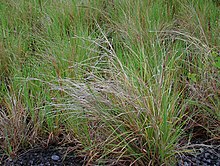
Thespesia populnea, commonly known as the portia tree, Pacific rosewood, Indian tulip tree, or milo, among other names, is a species of flowering plant belonging to the mallow family, Malvaceae. It is a tree found commonly on coasts around the world. Although it is confirmed to be native only to the Old World tropics, other authorities consider it to have a wider, possibly pantropical native distribution. It is thought to be an invasive species in Florida and Brazil.
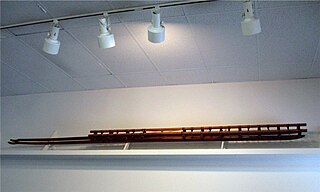
Hawaiian lava sledding is a traditional sport of the Native Hawaiians. Similar to wave surfing, heʻe hōlua involves the use of a narrow wooden sled. The sled is used standing up, lying down, or kneeling, to ride down man-made or naturally occurring courses of rock, often reaching speeds of 50 mph (80 km/h) or greater. In the past, Hawaiian lava sledding was considered both a sport and a religious ritual for honoring the gods.

Canarium ovatum, the pili, is a species of tropical tree belonging to the genus Canarium. It is one of approximately 600 species in the family Burseraceae. C. ovatum are native to the Philippines. They are commercially cultivated in the Philippines for their edible nuts and is believed to be indigenous to that country. The fruit and tree are often vulgarized with the umbrella term of "Java almond" which mixes multiple species of the same genus, Canarium.

In botany, an awn is either a hair- or bristle-like appendage on a larger structure, or in the case of the Asteraceae, a stiff needle-like element of the pappus.
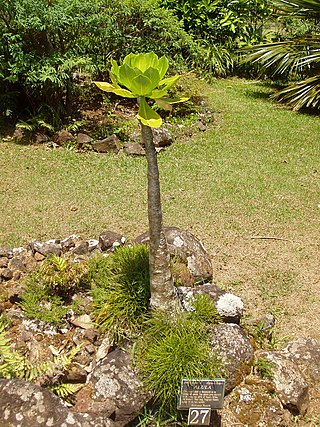
Brighamia insignis, commonly known as ʻŌlulu or Alula in Hawaiian, or colloquially as the vulcan palm or cabbage on a stick, is a endangered species of Hawaiian lobelioid in the bellflower family, Campanulaceae. It is native to the islands of Kauaʻi and Niʻihau. This short-lived perennial species is a member of a unique endemic Hawaiian genus with only one other species.

Hordeum jubatum, with common names foxtail barley, bobtail barley, squirreltail barley, and intermediate barley, is a perennial plant species in the grass family Poaceae. It occurs wild mainly in northern North America and adjacent northeastern Siberia. However, as it escaped often from gardens it can be found worldwide in areas with temperate to warm climates, and is considered a weed in many countries. The species is a polyploid and originated via hybridization of an East Asian Hordeum species with a close but extinct relative of Californian H. brachyantherum. It is grown as an ornamental plant for its attractive inflorescences and when done flowering for its inflorescence.

Sesbania tomentosa, commonly known as Oahu riverhemp and ʻōhai, is an endangered species of plant in the pea family, Fabaceae, that is endemic to the main Hawaiian Islands as well as Nihoa and Necker Island. It inhabits low shrublands and, rarely, dry forests, at elevations from sea level to 2,500 ft (760 m). Associated native plant species include akiʻaki, ilima, naupaka kahakai, and pili. Off-road vehicles, wildfires, grazing, and alien species competition have destroyed their habitat on the main islands, but they are still quite common on Nihoa and Necker. At least 2000 specimens grow on Nihoa, while there are far less on Necker.

Omiodes continuatalis is a species of moth in the family Crambidae. It is endemic to the Hawaiian islands of Kauai, Oahu, Molokai, Maui, Lanai and Hawaii. It was first cited as possibly extinct by W.C. Gagné and Francis Gard Howarth in 1982. It was listed as extinct by the Hawaiʻi Biological Survey in 2002 and the IUCN in 2003, but was rediscovered later in 2003.

Bromus diandrus is a species of grass known by the common names great brome and "ripgut brome".
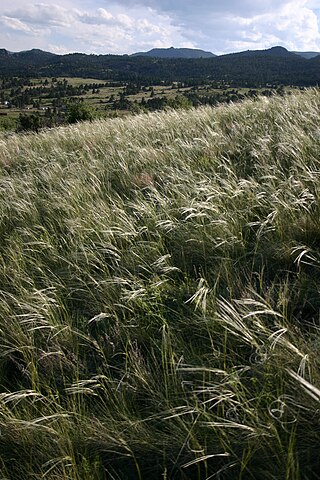
Hesperostipa comata, commonly known as needle-and-thread grass, is a species of grass native to North America, especially the western third. It has a wide distribution spanning from northern Canada to Mexico.

Heteropogon is a genus of annual and perennial plants in the grass family known generally as tangleheads, widespread primarily in tropical and subtropical regions.

Tussock grasses or bunch grasses are a group of grass species in the family Poaceae. They usually grow as singular plants in clumps, tufts, hummocks, or bunches, rather than forming a sod or lawn, in meadows, grasslands, and prairies. As perennial plants, most species live more than one season. Tussock grasses are often found as forage in pastures and ornamental grasses in gardens.

Kadua coriacea is a rare species of flowering plant in the coffee family known by the common name kioʻele. It is endemic to Hawaii, where it is known only from the island of Hawaiʻi and one individual remaining on Maui. It is a federally listed endangered species of the United States.

Hesperostipa spartea, formerly Stipa spartea, is a species of grass known by the common names porcupine grass, western porcupine grass, short-awn porcupine grass, porcupine needlegrass, and big needlegrass. It is native to North America, where it is widespread from British Columbia to Ontario in Canada and through the central and Great Lakes regions of the United States. It is a bunchgrass species in the genus Hesperostipa.

Nassella leucotricha is a species of grass known by the common names Texas wintergrass, Texas needlegrass, and Texas tussockgrass. It is native to the south-central United States and much of Mexico.
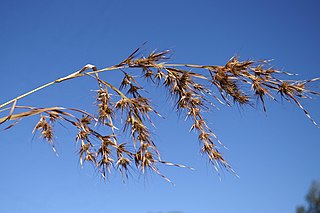
Themeda quadrivalvis is a species of grass known by the common names grader grass, habana grass, and kangaroo grass, not to be confused with Themeda triandra, which is also known as kangaroo grass. It is native to India, Nepal, and Malaysia. It can also be found in many other places as an introduced species and often a noxious weed. It occurs in the United States, New Caledonia, Fiji, Mauritius, Thailand, Indonesia, Papua New Guinea, China, the Middle East and tropical America. It is a troublesome exotic weed in Australia, especially in northern regions. It is also an agricultural weed in crops such as sugar cane and lucerne.
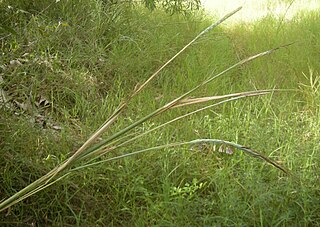
Heteropogon triticeus is a tropical, perennial tussock grass with a native distribution encompassing Tropical and Temperate Asia, Malesia and Northern and Eastern Australia. The plant grows to over 2 metres (6.6 ft) in height and is favoured in most environments by frequent burning. The plants develop characteristic dark seeds with a single long awn at one end and a sharp spike at the other. The awn becomes twisted when dry and straightens when moistened, and in combination with the spike is capable of drilling the seed into the soil.

Oplismenus hirtellus is a flowering perennial plant from the family Poaceae that can be found on every continent in the world except Antarctica, growing mostly in coastal tropic and subtropic regions as well as tropical and subtropical islands such as Hawaii, New Zealand, Australia and Madagascar.

Bothriochloa pertusa is a species of grass. It is widely used as a fodder and a graze for livestock.
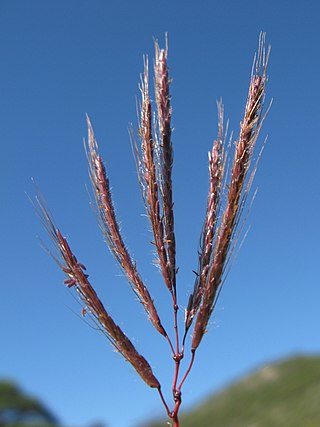
Dichanthium annulatum is a species of grass in the family Poaceae. It is commonly used as a forage for livestock.
